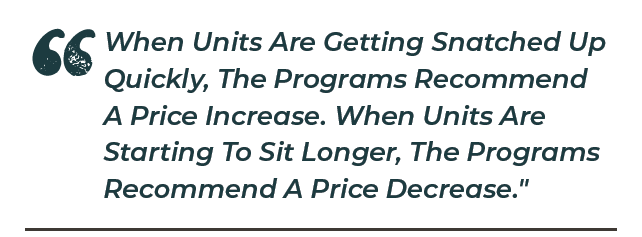The Myth Of Computerized Price Fixing In Rental Housing

There’s a growing misconception that large residential property management companies charge above market-rate rent by using computerized pricing algorithms. This claim is the basis of both a highly publicized class action lawsuit and a US Department of Justice probe/ PR campaign. The more complicated reality is rental price fixing does not happen. The less dramatic truth is that algorithmic pricing models allow rental housing providers to maintain lower vacancy rates, which both increases profitability and lowers rent prices.
Competitors communicating about future prices is illegal for a good reason. If one provider (one big enough to have an impact on the market) agreed to artificially raise rates with another provider (one also big enough to have an impact on the market), they’d have the potential to “fix prices.” Coordinated price setting by competitors can create monopoly-like powers, which always hampers a free market.
However, the problem lies in communication about future prices. Information about current or past prices (whether it be a year ago, a day ago or a second ago) does not manipulate the market but merely measures it. Accurately measuring a market is good for suppliers and consumers and critical to the functioning of any free market.
Opponents of algorithmic pricing models spend all their time arguing that communicating through a computer is no different than exchanging information on the phone (true) and that, if enough of the market used the same program, the users would collectively achieve a large share of the market (also true). However, they completely ignore that all this computerized communication is about current and past prices - not future prices.
While trial-and-error pricing is a reasonable strategy to measure the market for many businesses, it eliminates housing and revenue by the day for property managers. If you're in the business of selling shoes and you mistakenly price them too high, the next day you cut your prices and sell the shoes. Nothing is lost other than the relatively small cost of delaying the sale by a day. Renting homes is not like selling shoes. Every day that a rental housing unit sits vacant is a day of rent lost forever. Pricing a rental unit too high incurs the cost of permanent loss of inventory.

Algorithmic pricing models are extremely valuable to the rental housing market because they reduce trial and error pricing. When units are getting snatched up quickly, the programs recommend a price increase. When units start to sit vacant longer, the programs recommend a price decrease. The algorithm gets the housing provider closer to the elusive “perfect information” necessary for free markets to function at peak efficiency.
The primary benefit of these programs is the speed of information. Information on rental and vacancy rates has always been collected and used to set pricing. However, collecting that information has historically been very time intensive, and the information has been published no more frequently than quarterly, forcing managers to rely on 3-6-month-old data. A good computerized pricing system also carefully tracks and allows comparisons of all attributes of various rental units. By avoiding comparing apples to oranges, housing providers can avoid applying price changes in urban one-bedroom units to unrelated suburban three-bedroom units, etc.
Like every product in a free market, rental rates go up and down based on supply and demand. When there are not enough rental housing units to go around, consumers bid against each other, and prices rise. When there are more rental housing units than needed, rental housing providers lower their asking prices until someone is eventually willing to rent the unit.
The fact that all housing costs (including rental housing costs) are uncomfortably high is caused by unintended consequences of government policy. Governments will not allow people to build enough housing units to meet demand. This artificial restriction on the supply of rental housing units results from a myriad of restrictions and taxes on development that include density prohibitions, height limitations, development fees, sales taxes on construction materials, accessibility requirements, energy efficiency requirements and neighborhood approvals. While all of these policies have some rationale behind them, we have reached a point where 37% of the cost of a new residential rental housing unit is spent on some form of regulatory compliance. Consequently, we are all being artificially incentivized to build too few housing units.
We should not be calling on rental housing providers to abandon computers and mathematics or to hide rent and vacancy rates. Instead, we should be calling on governments to allow more homes to be built.
Computer programs that identify when there are not enough housing units to go around are not the problem. People with hostility against these formulas are engaged in the flawed logic of blaming the thermometer that it is too cold outside.
